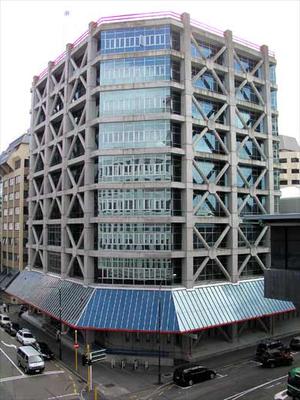Engineering earthquake-resistant buildings
Chile’s 8.8-magnitude earthquake was much more powerful that Haiti’s 7.0-magnitude tremor; yet, Haiti’s quake claimed an estimated 300,000 dead, while Chile’s quake claimed around 800; the reason: Chile enforced building codes for earthquake-resistant structures after the 1960 9.0-magnitude earthquake; the corrupt, indifferent, and ineffective governments of Haiti never bothered to develop a meaningful building code, let alone enforce one

Wellington, New Zealand's earthquake-resistant central police station // Source: teara.govt.nz
Two recent earthquakes — the 7.0-magnitude one in Haiti and the 8.8-magnitude in Chile — were destructive, but the differences in their consequences highlight the importance of engineering and testing earthquake-proof systems. The Chile earthquake was much more powerful than the one in Haiti — yet, the Chile earthquake caused only a fraction of the casualties (now about 800) compared with the 300,000 people estimated to have died in Haiti.
David Butcher writes that Some seismologists suggest that one reason for the difference in the death tolls is that buildings in Haiti were constructed quickly and cheaply, while Chile enforced building codes for earthquake-resistant structures after a 9.0-magnitude earthquake in 1960. “Since the turn of the century, earthquakes have directly or indirectly (including tsunami) claimed the lives of more than 640,000 people, four times more than in the preceding two decades, and proportionately more than the global increase in population would anticipate,” according to a recent paper in the journal Nature.
“If buildings are not made earthquake resistant, the toll is likely to continue to rise as cities grow in population,” Roger Bilham, a professor of geological sciences at the University of Colorado and one of the first seismologists to visit Haiti after the recent earthquake there, writes.
Butcher writes that building to withstand natural forces is not a losing battle, and that many engineers and architects believe it is possible to design and construct an earthquake-proof building. “At study centers throughout the country, many experts are working to develop new technologies that could minimize the dire costs of a major quake,” he writes.
“Technology designed to keep buildings from collapsing works essentially in two ways,” a CNN Tech report this week explains: “By making buildings stronger, or by making them more flexible, so they sway and slide above the shaking ground rather than crumbling.”
-read more in Roger Bilham, “Lessons from the Haiti Earthquake,” Nature 463 (18 February 2010): 878-79 (doi:10.1038/463878a); and Richard A. Lovett, “Why Chile Fared Better than Haiti: Building Codes and Earthquake Origins Help Explain Levels of Destruction,” Nature (1 March 2010) (doi:10.1038/news.2010.100) (Lovett’s article: sub. req.)
